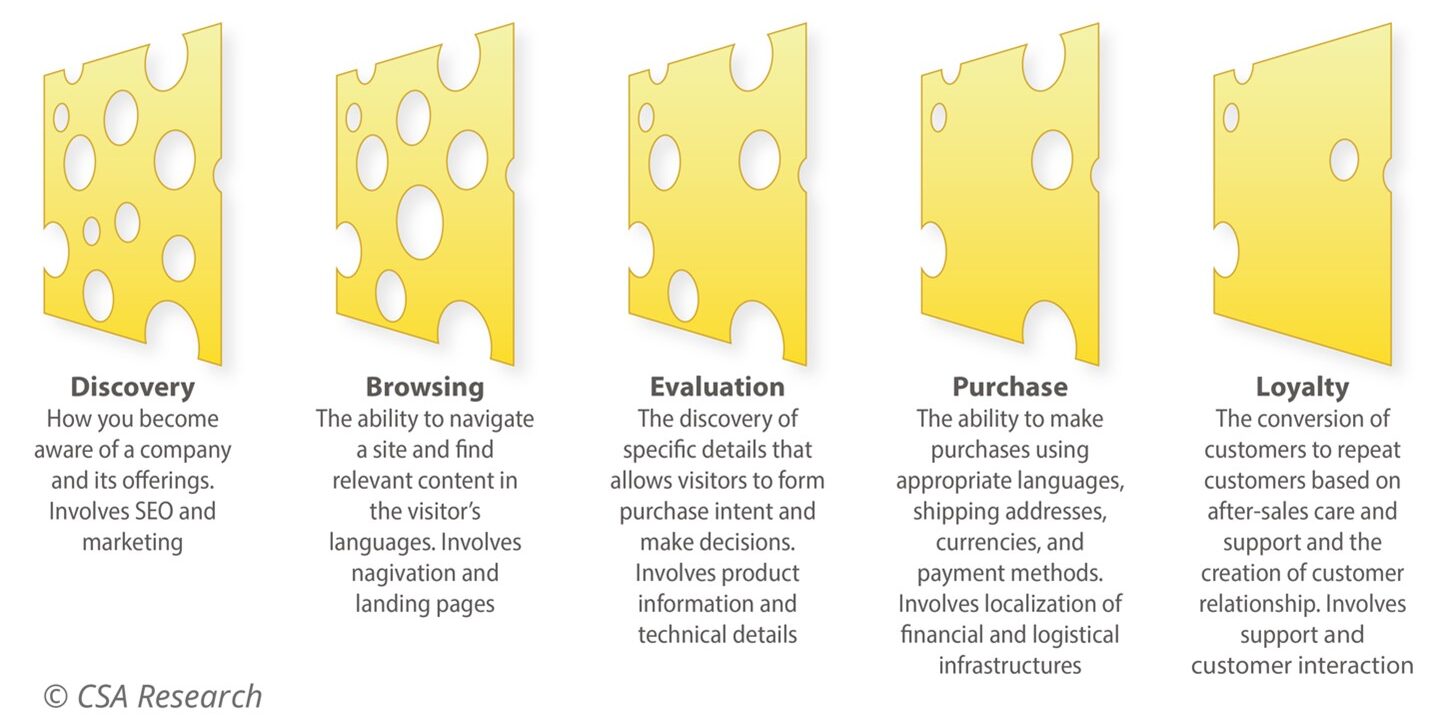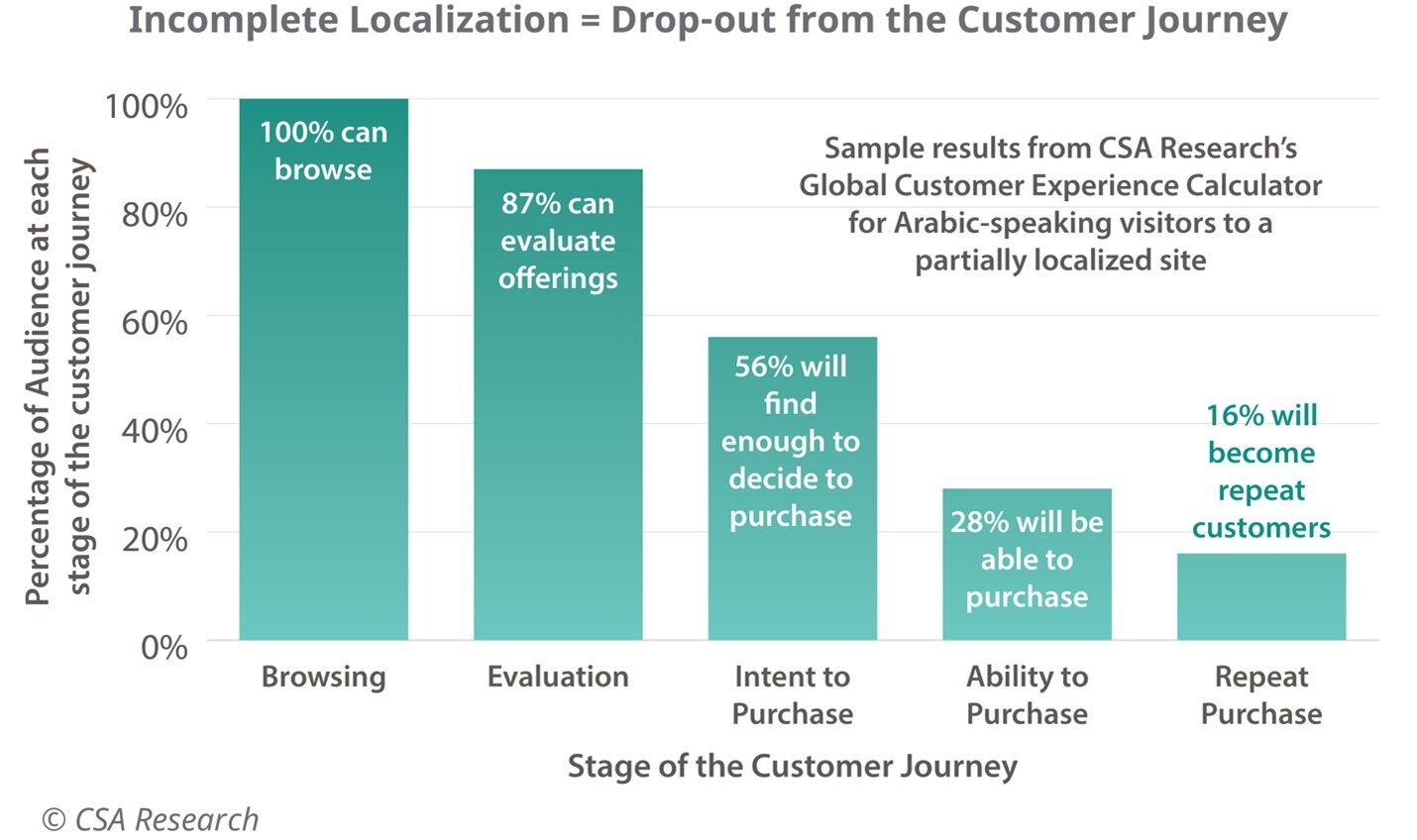Localization Leadership – Exclusive to Vistatec.com
Arle Lommel, Senior Analyst, CSA Research
Following our articles 5 Key Principles to Establish Yourself as a Strategic Leader and How to Capture and Measure Relevant Localization Metrics from our Localization Leadership series, we have invited guest writer and localization expert Arle Lommel to collaborate with us for this month’s article.
If you have ever tried to navigate a website in a language you do not understand, you will know how difficult and frustrating it can be. Even with browser-based machine translation, the results can range from quite good to useless. As a result, companies translate their online experience to ensure success. However, they typically only translate about 5% of their website into most languages. This gap in language access leads to a sub-par customer experience as site visitors quickly run out of engaging content that they can read.
Even if you do manage to have success in a country/locale for which you did not provide local translation, that only shows you that some speakers will tolerate a subpar experience, either because they speak English well enough to make do or because they are particularly motivated. But this does not tell you about the missed opportunity and revenue potential for those who visited and then abandoned the site because it was not in their language. This can lead to statements like “we do not need to translate into German because all Germans who buy from us speak English.” This is a classic example of what is known as “survivorship bias,” which can lead to faulty assumptions about your potential buyers.
One way to think about how to address this issue is to turn to a powerful model for disaster prevention, James T. Reason’s “Swiss Cheese Model”. For those who are unfamiliar with it, the Swiss Cheese Model visualizes safety precautions as being like slices of Emmental Swiss cheese: no single barrier can stop all threats and they have holes in them through which risks can pass. The goal then is to have multiple barriers so that the holes in them do not align and any threat that makes it through one or more of them will be stopped by another one.
For example, if you want to protect a public figure addressing a crowd, you would have a security perimeter with metal detectors, guards in the crowd, physical barriers around a stage, and a physical inspection of the venue before the event. Although bad actors might make it through any one of these precautions, the hope is that at least one would stop them before they can cause harm.
Reverse Swiss Cheese Model
CSA Research has created what we call the “Reverse Swiss Cheese Model” for international customer experience. It inverts the standard Swiss Cheese Model, in that its goal is to create holes through which site visitors can pass on their way to becoming loyal customers. In this view, we treat each stage of the customer journey like a piece of Emmental: if visitors find needed content in their language, they can pass through each stage to the next. If they cannot find or read relevant content, they hit a barrier of thick cheese, and their customer journey halts.
CSA Research identifies five phases in the customer journey for consumer websites. For B2B sites or direct sales models, these phases may be different, but the same general principles apply. As prospects move through these phases, they become customers and, potentially, repeat customers. Their value to you increases as they progress along this path.
Five Stages of the International Customer Journey as Slices of Cheese

• Discovery. This is the stage when potential customers become aware that you exist. They do not yet have a firm purchase intent, but they have a problem they want to solve or a need they want to fulfill. They may use web searches to find what they are looking for or may ask friends. To get customers through this phase, you need to provide search engine optimization (SEO) and marketing content in their language and make sure you have the appropriate technical setup to support languages.
• Browsing. At this stage, you need to have site navigation and basic landing pages localized so that visitors can navigate your site. At this point, visitors are becoming worth more because they are interacting directly with your brand and content and are at least curious about your offerings. However, if they do not immediately find what they are looking for, they will leave. This means you need to make it easy for them to find their language and relevant content.
• Evaluation. Prospects at this stage have moved beyond simply looking around. They are seeking specific information that will help them decide whether to purchase or not. Individuals at this stage are increasingly valuable because they are likely to make a purchase, but they need to find enough information to convince them to give you money. A few marketing pages are unlikely to be sufficient: they need concrete information to inform a decision.
• Purchase. This stage represents the point when a visitor has decided to give you money. It is the first stage where site visitors add concrete, rather than potential, value to your business. Here, they need to find mechanisms that support their language, their preferred payment methods and currencies, shipping to their country, support for entering addresses in the format needed for their location, and anything else involved with giving you money and receiving goods. Far too often, companies localize everything but this and then wonder why nobody buys from them.
• Loyalty. If visitors can make it through all the previous stages and like your goods or services, they now require after-sales support and care. They need follow-up in their language. If they have a positive experience, they are likely to be repeat purchasers and recommend your business to others. These are the most valuable individuals because they can provide you with a recurring revenue stream.
Online Multiligual Experience

But let’s consider what happens far too often. Looking at the diagram above, which depicts the online multilingual experience for a UK-based personal care products brand, we see that the Albanian visitor never even gets past discovery: simply never even learn about the company because their Albanian-language searches turn up nothing from the company. The other prospects find marketing content and are interested, but when the Finnish individual tries to browse to find what they are looking for, he discovers that the localization was only for a few marketing pages in his language and he leaves for a competitor.
As the other individuals move on, they encounter other potential barriers. The French speaker finds a product they are interested in, but when they click on the product information page, they are sent to an English page they don’t understand and so leave to find a product elsewhere. The German, having found what they need about the products, wants to buy them, but – after several frustrating minutes – discovers that the available shipping options will not work for their mailing address in Munich. Only the Spanish customer is able to complete a purchase and go on to become a loyal customer.
At each stage, it is your job to open up holes through localization that allow visitors and prospects to move on. Additionally, they usually spend the most on localizing the content at the early stages when individuals have the least value to their business, but neglect to translate for later stages. Of course, they have to translate marketing and other materials to get them through to later stages, but leaving the job half done is likely to lead to disappointment: 75% of customers globally are generally not willing to make purchases from unlocalized sites.
At CSA Research, we have applied this model in a free-to-use tool we call the Global Customer Experience Calculator. It takes the approach seen in the Reverse Swiss Cheese Model and calculates the likelihood that individual customers in our “Can’t Read, Won’t Buy – B2C” panels will make it through multiple stages in the customer journey based on their language preferences and how well organizations localize their content. Strategists can use this model to understand how incomplete localization affects the revenue for each country-language pair and how changing specific aspects of their language strategy would affect their sales.

Beyond the requirement for having the right language, our research has shown that even when companies do localize content, they frequently erect smaller barriers that deter customers and close off spaces in the web experience for international site visitors. By contrast, as your globalization maturity increases, you will look for opportunities to create openings in your walls of cheese to help prospects and customers find content in their own language. Seriously and systematically planning for international requirements can help you create an experience that invites customers to reach their goals rather than blocking them along the way.
